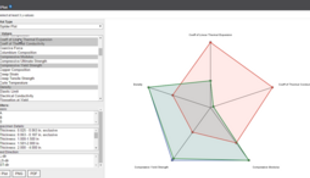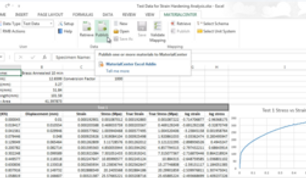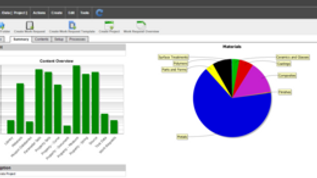Materials Lifecycle Management
MSC Software’s MaterialCenter – a Materials Lifecycle Management System – is designed from the ground up to link material specialists to mechanical simulation. A process and data management system, MaterialCenter automatically captures the data from integrated processes ensuring full traceability across the enterprise and throughout the product lifecycle. It addresses the unique requirements of exponential growth of complex materials in driving product innovation (plastics, composites) MaterialCenter works directly with many commercial CAE products including include many of MSC’s flagship products, MSC Nastran, MSC Fatigue, Marc, and e-Xstream Digimat.




WHY MATERIALCENTER IS RIGHT FOR YOUR COMPANY TODAY?
Drawn from the collective experience of the world’s largest OEM’s, MaterialCenter is the single point of entry for all of your materials related activities including physical test data entry and reduction, multi-scale materials modeling, approval workflow and the export of simulation ready data to analysis. This guarantees that engineers are using a consistent source of approved materials derived from traceable integrated processes. The result is improved simulation fidelity, reduced data loss and elimination of tedious manual data management activities; empowering engineers to focus on driving new and innovative products. Proven scalability to 100,000’s of processes and petabytes of data ensures that MaterialCenter will meet the needs of material and simulation engineers alike for many years to come.
Using Your Materials to Drive Engineering Innovation - Your Company’s Advantage
Dashboards enable quick evaluation of materials data management projects and management oversight
Work request and approval workflow keep projects on track
All materials-related processes, input and output are documented via Audit Trail
Process-oriented, automation approach to data management implemented to minimize manual data entry activities
Robust and intuitive interface for data search, retrieval and comparison for all data types – tabular, curves, images, etc.
Web-based interface to data management processes enables distributed data authoring and maintenance
Built-in job queue interface optimizes execution of materials simulation processes

Secure, Reliable, and Fast Access to Material Data
MaterialCenter Databanks is a comprehensive source of material information needed by engineers for research, product design and development, provided in conveniently accessible electronic format. The databanks are developed and maintained through MSC's partnerships with premier sources of materials information.
MaterialCenter Databanks fits easily into an organization’s engineering process to achieve high return on investment with the following capabilities:
Provide designers and engineers with material information in a quick and traceable manner.
Validate your company's materials with the latest test data and reference sources from industry.
Interface with MaterialCenter to optimize searching, material down-selection, and data export.
Export data to third-party client applications.
Convert units that adhere to ASTM E-380 standards.
Why MaterialCenter Databanks
Improve time-to-market: Reliable data readily accessible helps engineers choose the right materials for their designs
Reduce errors: By accessing data in a standard format from reliable sources, errors due to incorrect inputs can be avoided
Improve quality: With access to a large number of material alternatives, engineers can choose the optimal set of materials by easily comparing and evaluating multiple design options
Control costs: By streamlining the process of material selection and standardizing the material selection process, save on material and design costs, and reduce risk.
MMPDS Databank
MMPDS Databank is based on MMPDS-08 (Metallic Materials Properties Development and Standardization) and contains the highest quality, comprehensive, electronic property data on metal alloy systems available. Battelle Memorial Institute maintains this databank, validates data entry, and renders new test data. MMPDS is comprised over 5,000 material records from 15 different material property databases.
The MMPDS-08 Databank currently contains
-
Design Mechanical and Physical Property tables from the source document,
-
Most of the supporting data tables, and
-
Figures that represent the results of numerous different property tests.
-
The information includes raw or reduced curve data for tests such as
-
Tensile and compressive stress-strain (Ramberg-Osgood),
-
Fatigue,
-
Percent room temperature value versus temperature for various properties, like coefficient of thermal expansion, conductivity and specific heat.
JAHM Databank
The MPDB Temperature-Dependent Databank is based on the Windows software product of the same name, developed by JAHM Software, Inc. for use by engineers. This dynamic and rapidly growing databank provides 2,722 materials and 23,197 sets of temperature dependent data in graphical format, fully pedigreed.
Material coverage includes but is not limited to:
-
carbon compounds,
-
ceramics,
-
chemical elements,
-
ferrous and nonferrous metals,
-
intermetallics,
-
plastics,
-
optical materials, and
-
semiconductor materials.
-
Analysis-ready properties as functions of temperature including specific heat, elastic modulus, tensile yield strength, coefficient of thermal expansion, are available for these materials in this databank.
Material Selector Databank
The MSC Materials Selector Databank Library is a collection of two Databanks derived from MACHINE DESIGN's Materials Selector, Penton Media, Inc., Cleveland, OH. The published version was originally compiled from data provided by various materials producers.
The MSC Materials Selector Databank contains over 3200 material records and sections of general information with properties and useful information in a number of categories:
-
mechanical properties,
-
corrosion resistance,
-
fabrication and processing methods,
-
composition,
-
physical properties,
-
available forms, designations and grades,
-
thermal properties and treatments,
-
electrical properties,
-
chemical resistance and properties, etc.


